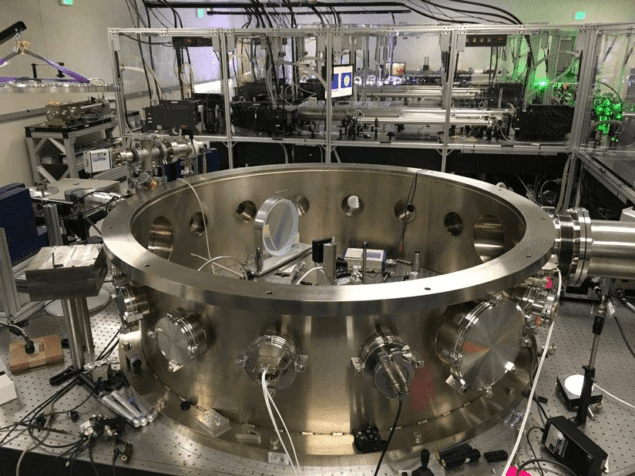
Smaller, cheaper neutron sources and new opportunities for simulating the extreme conditions at the centre of stars are among the possible benefits of new research carried out by physicists in the US and Germany. The group directed rapid-fire pulses of intense blue light from a compact laser at arrays of nanostructures to generate a dense plasma yielding large numbers of neutrons created by nuclear fusion.
Scientists have built ever more energetic lasers in the quest to demonstrate nuclear fusion’s feasibility as an energy source. The National Ignition Facility (NIF) in California, for example, generates pulses with a whopping 1.8 MJ of energy, in order to compress tiny pellets of deuterium and tritium to the point where the nuclei fuse and emit copious numbers of neutrons. The aim is to achieve ignition, when the alpha particle released by the fusing nuclei provides the heat for a self-sustaining reaction – with the energy of the emitted neutrons ultimately being tapped to produce electricity. However, NIF is enormous – occupying the area of three football pitches – and, like other high-energy lasers, can only fire a handful of times a day.
Some researchers are instead working on less energetic but more rapid-fire lasers. These will never get anywhere close to ignition, but can still achieve exceptionally high intensities – thanks to the extreme brevity and hence power of their pulses. Such lasers can create plasmas with very high energy densities ideal for studying extreme astrophysical environments, for example. These devices could also potentially be used as compact sources of neutrons, which probe atomic structure in ways not possible with X-rays. Neutrons are usually produced at large accelerators or reactors and a compact source would be welcomed by scientists.
Rapid bursts
In the latest work, Jorge Rocca of Colorado State University in the US and colleagues used a titanium-sapphire laser to generate pulses lasting just 60 fs with up to 1.65 J of energy. Capable of being fired three times a second at arrays of deuterated polyethylene nanowires each about 5 µm long and either 0.2 µm or 0.4 µm in diameter, the pulses rip electrons from the surface of the nanowires. The electrons then get accelerated to very high energies within the void between the wires, causing the wires to heat up rapidly and explode. The resulting plasma accelerates deuterons to energies up to several megaelectronvolts, causing the deuterons to fuse and generate rapid bursts of neutrons.
We are able to produce fusion on the microscale, and to produce a large number of neutrons very efficiently
Jorge Rocca, Colorado State University
The researchers used nanowire arrays in order to excite as many deuterons as possible. As Rocca explains, the laser pulses easily penetrate the space between the nanowires and therefore heat up a much larger volume of material than they could if striking a flat, solid surface (which they would barely enter given the same light intensity). Also crucial in the experiment, he says, was frequency doubling the usually infrared output of the titanium-sapphire laser to create blue pulses. This allowed the team to filter-out less intense pre-pulses that would otherwise destroy the nanowires ahead of the main pulse.
Carrying out their experiment in this way, Rocca and colleagues found they could produce neutrons more efficiently than ever before using laser pulses at around the 1::J level – generating up to 2 million fusion neutrons per joule. That efficiency, they showed, was about 500 times higher than could be obtained by firing the laser pulses at flat targets made from the same material in solid form (which is about five times denser than the arrays).
Flash of neutrons
“We are able to produce fusion on the microscale, and to produce a large number of neutrons very efficiently,” says Rocca. “You have a flash of neutrons coming out.”

Consortium sets out to build European laser plasma accelerator
While the efficiencies achieved were higher than those obtained with similar-sized lasers, they were nevertheless lower than those at NIF- which recently yielded some 8×1015 neutrons per pulse, or about 4 billion neutrons per joule. However, Rocca and colleagues did find that the neutron yield in their experiment shot up as they increased the energy of their pulses, in line with predictions they made using computer simulations.
The group is now working to further raise the pulse energy in order to boost the yield enough to do neutron radiography. In the meantime, Rocca says the team has been approached by other groups interested in using their neutron source to calibrate neutrino detectors.
The research is reported in Nature Communications.



